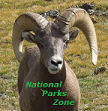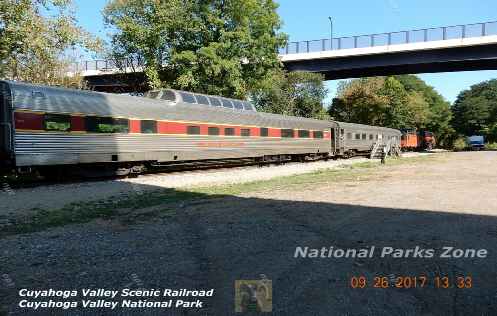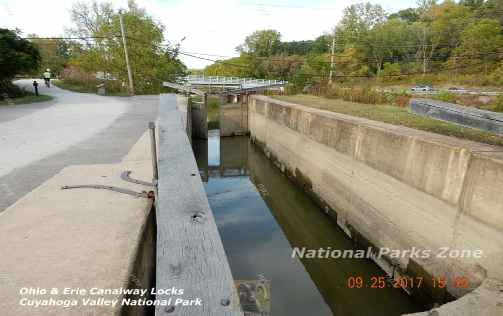Copyright © 2014-
All Rights Reserved

Updated 02/11/23 7:04 PM
Other Resources
Cayahoga Valley National Park on the National Parks Service website -
Cayahoga Valley National Park -
Cayahoga Valley National Park -
Cayahoga Valley National Park -
Cayahoga Valley National Park -
Cayahoga Valley National Park -
Cayahoga Valley National Park -
Cayahoga Valley Scenic Railroad -
Cayahoga River.org
Rock and Roll Hall of Fame -
Cuyahoga Valley National Park
Cayahoga Valley National Park stretches between Cleveland and Akron and provides an excellent way to leave the city life behind and enjoy natures beauty.
Ohio
2009
About The Park
Cuyahoga Valley National Park is an unusual park, quite different from most other national parks because of its location between two cities. It’s pretty much a sliver of land that is mostly only about a mile wide. It follows the Cuyahoga River as it twists and turns for about 23 miles. In total the park only covers about 50 square miles. Several interstate highways and many local roads cross it.
Driving from one point of interest to another often has you exiting the park into surrounding communities and reentering at other points. Its proximity to both Cleveland and Akron, Ohio probably accounts for its 2.2 million visitors and its ranking in 2017 as the 14th most visited out of the 62 national parks. Wherever you go in this park there will be people especially on the weekends.
The park is part of a larger system that includes units from the Cleveland Metroparks system and, towards the southern end of the National Park, Akron’s Summit Metro Parks system. Units of Cleveland Metroparks and Summit Metro Parks are adjacent to the National Park and are practically indistinguishable from it. The Cuyahoga Valley National Park and the Metro parks host four public golf courses, fishing, canoeing and kayaking on the Cuyahoga River and two ski areas.
All along the length of the park there are educational attractions. Among them are the Brecksville Nature Center, the Squire Rich Historical Museum, the Terra Vista Natural Study Area, the Leonard Krieger Canalway Center, the Cuyahoga Valley Environmental Education Center, a Canal Exploration Center and Hunt House with its child friendly exhibits.
The park has 125 miles of hiking trails. It also several waterfalls with the 60 foot high Brandywine Falls being among the most popular.
The Cuyahoga River was probably once the most infamous river in the United States. The river runs through Cleveland and into Lake Erie. As Cleveland became a major manufacturing center the river became heavily polluted and was totally devoid of fish between Akron and Lake Erie. Amazingly it actually caught fire at least 13 times. The most famous one on June 22, 1969 was ignited by a spark from a passing rail car. The largest fire in 1952 caused over 1 million (1952) dollars in damage to boats, a bridge, and a riverfront office building. Time magazine described it as “the river that oozes rather than flows”. It is said to have spurred the American environmental movement. Fortunately over the past 50 years it has been cleaned up to the point that the American Rivers Conservation Association named it “river of the year” in 2019.
All in all Cuyahoga Valley National Park is an interesting place with lots to do and see. Driving in and out of the local communities somehow added to the charm because I envied those people who had a national park in their backyard. I can’t say that, having visited 57 national parks by the time I got to Cuyahoga Valley, I was really enthusiastic about visiting a park sandwiched between two large metropolitan areas. It certainly turned out to be more than I expected.
The people in the Cleveland-
Wildlife
Among the animals found in the park are gray and red foxes, beavers, river otters, minks, coyotes, raccoons, muskrats, skunks, opossum and white-
Lodging
Lodging in the National Park itself is extremely limited. These two bed-
Inn at Brandywine Falls
The original farmhouse was built in 1848 and is adjacent to the 60 foot very popular Brandywine Falls. It now has six rooms and is a modern bed-
Stanford House
This is also located close to the Towpath and just a short hike from Brandywine Falls. It has nine bedrooms and has communal baths and showers. It is also in the bed-
Hiking
Brandywine Gorge Trail
This is a 1.5 mile trail that follows the edge of the gorge down to creek level. The trail head is near the Inn at Brandywine Falls Bed & Breakfast. You can also make this a 3.8 mile out-
Ohio and Erie Canal Towpath Trail
One of the features of the park is the Ohio and Erie Canal Towpath Trail. This paved and gravel trail follows the Cuyahoga River and passes through wetlands, meadows, forests, rock ledges, gorges and a number of historic sites. As a towpath its purpose in certain places was to have people or animals pulling the barges along. There’s a number of old locks along the canals length. The canal was built between 1825 and 1832. The trail is popular with bicyclists and people who come to see the fall colors.
The Ledges Overlook (Ritchie Ledges) loop trail
While the overlook is only a 200’ walk from the road, there is also a 2.2 mile loop trail. It is a moderate hike with only a 105’ elevation gain. Sharing the same parking area are two easy hikes: the Pine Grove Trail which is a 1.2 mile loop and the Forest Point Trail which is a ½ mile loop.
Tinker’s Creek Gorge
This can easily be viewed from an overlook on the Gorge Parkway in the northern section of the park.
Bridal Veil Falls
A bit past the overlook for Tinker’s Creek Gorge there is a short hike to Bridal Veil Falls.
Other Points of Interest
Cuyahoga Valley Scenic Railroad
This railroad follows the Cuyahoga River and runs the length of the park. It makes 11 stops between the north end of the park, about 10 miles south of Cleveland, and North Akron at the south end of the park. There are Rangers on board to explain what you are seeing and some local history. You’re allowed to exit at any of the stops and reenter the train on its way back. You reserve a seat but once you get off there is no guarantee that seat will be available when you get back on. There are various levels of seat pricing with seats in the car with the observation dome being more expensive.
We took the trip for the full-
The railroad is also used by bicyclists who get a special $5 rate. There’s a similar program for hikers, runners and kayakers.
The Cuyahoga Valley Scenic Railroad Organization is nonprofit and volunteer supported and is run in partnership with Cuyahoga Valley National Park. All of the railroad cars and the locomotives are vintage stock acquired from various other railroads around the country and refurbished.
Rock and Roll Hall of Fame
This is a great way to spend an afternoon (or whole day) especially if the weather is not good. The pyramidal-
Cayahoga Valley National Park Photo Gallery


Other National Parks Within a Day’s Drive
Indiana Dunes National Park America’s newest national park as of February, 2020 is 311 miles east and about a 5 hour drive.
New River Gorge National Park Where you can see a steep gorge and a graceful steel arch bridge that rises 876 feet above the river. It is 310 miles to the south and about a 5 hour drive.
Mammoth Cave National Park See the largest cave system in the U.S. It 428 miles to the south and about a 6.5 hour drive
Shenandoah National Park where you can drive the scenic Skyline Drive is 427 miles to the east and about a 7 hour drive.
*N*P*Z*
National Parks Zone